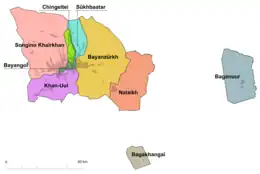
Map of the districts of Ulaanbaatar
Ulaanbaatar is divided into nine düüregs (Mongolian: Дүүрэг) or municipal districts: Baganuur, Bagakhangai, Bayangol, Bayanzürkh, Chingeltei, Khan Uul, Nalaikh, Songino Khairkhan and Sükhbaatar. Each district is subdivided into khoroos, of which there are 173. Each düüreg also serves as a constituency that elects one or more representatives into the State Great Khural, the national parliament.
Demographics
| Düüreg | Mongolian | Khoroos | Population
01.01.2006 |
Annual
growth (%) |
Population
01.01.2007 |
Annual
growth (%) |
Population
01.01.2008 |
Annual
growth (%) |
Population
01.01.2009 |
Area
km2 |
Density
/km2 |
|---|---|---|---|---|---|---|---|---|---|---|---|
| Bagakhangai | Багахангай | 2 | 3,776 | 1.4 | 3,827 | 1.0 | 3,864 | -3.2 | 3,742 | 140.0 | 26.7 |
| Baganuur | Багануур | 5 | 25,261 | 1.9 | 25,731 | 0.9 | 25,969 | -0.4 | 25,877 | 620.2 | 41.7 |
| Bayangol | Баянгол | 25 | 160,479 | 0.2 | 160,818 | 2.7 | 165,159 | 2.5 | 169,278 | 29.5 | 5,738.2 |
| Bayanzürkh | Баянзүрх | 30 | 196,132 | 7.9 | 211,614 | 4.7 | 221,565 | 6.2 | 235,192 | 1,244.1 | 189.0 |
| Chingeltei | Чингэлтэй | 19 | 130,501 | 1.8 | 132,883 | 2.4 | 136,014 | 2.9 | 140,019 | 89.3 | 1,568.0 |
| Khan Uul | Хан Уул | 21 | 87,912 | 3.4 | 90,925 | 4.1 | 94,670 | 4.4 | 98,815 | 484.7 | 203.9 |
| Nalaikh | Налайх | 8 | 26,529 | 2.9 | 27,297 | 3.1 | 28,152 | 3.4 | 29,115 | 687.6 | 42.3 |
| Songino Khairkhan | Сонгинохайрхан | 43 | 204,587 | 3.2 | 211,056 | 4.4 | 220,295 | 5.5 | 232,326 | 1,200.6 | 193.5 |
| Sükhbaatar | Сүхбаатар | 20 | 117,233 | 5.0 | 123,041 | 5.2 | 129,486 | 2.8 | 133,108 | 208.4 | 638.7 |
| total | 132 | 952,410 | 3.7 | 987,192 | 3.8 | 1,025,174 | 4.1 | 1,067,472 | 4,704.4 | 226.9 |
Although administratively part of Ulaanbaatar, Nalaikh and Baganuur are separate cities. Bagakhangai and Baganuur are noncontiguous exclaves, the former located within the Töv Province, the latter on the border between the Töv and Khentii provinces.
References
- ↑ Statistics office of the city of Ulan Bator, Archived 2011-07-22 at the Wayback Machine stat2701.pdf Archived 2007-11-10 at the Wayback Machine pop2006.01.01.pdf Archived 2007-02-22 at the Wayback Machine
This article is issued from Wikipedia. The text is licensed under Creative Commons - Attribution - Sharealike. Additional terms may apply for the media files.
